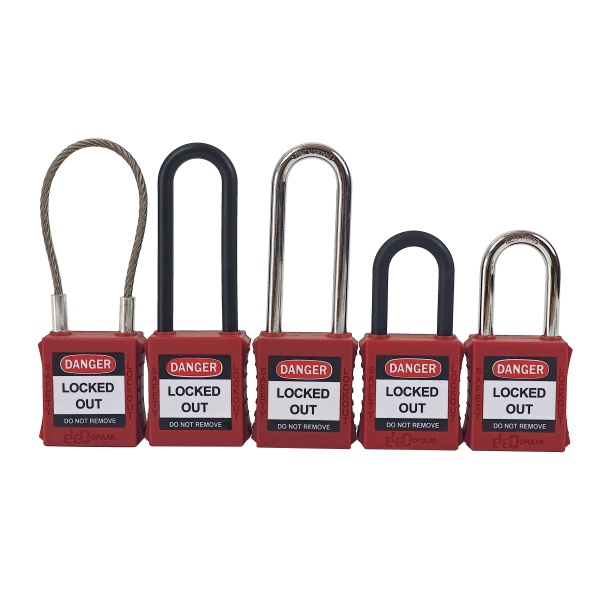Choosing the right lockout padlock is one of the most important steps in building a safe and compliant lockout/tagout (LOTO) program. Since padlocks play a direct role in isolating hazardous energy, the decision should be based on technical needs, workplace conditions, and safety requirements—not guesswork. To help you make a well-informed choice, the following guide walks through every key factor that determines whether a padlock is truly suitable for your facility.
To begin with, it is important to understand why selecting the correct lockout padlock is so critical. Padlocks serve as the physical barrier that prevents accidental equipment startup, protects workers during maintenance, and supports compliance with energy control regulations. Because each machine and environment has different risks, choosing the wrong padlock can weaken the entire LOTO procedure. For this reason, selecting the right padlock should be treated as part of your overall safety strategy, not merely a purchase.

Before choosing a padlock, you must first evaluate what your facility actually requires.
First, assess all energy isolation points involved in your operations. These may include electrical disconnects, mechanical blocks, pneumatic valves, hydraulic systems, thermal energy, or chemical pressure. Since each source behaves differently, each one may require a specific padlock material or shackle design.
Next, consider how often maintenance occurs. A small workshop with occasional lockout needs will require simpler padlock management, while a large industrial plant may need hundreds of padlocks with strict identification and tracking systems. Understanding this early helps prevent confusion later.
After identifying your needs, the next step is choosing the appropriate padlock body material. This decision directly affects durability, safety, and usability.
For electrical lockout points, a non-conductive lock body is essential. This type of lockout padlock reduces the risk of electrical conduction, protects workers from secondary hazards, and prevents damage to sensitive components.
In contrast, metal lock bodies such as aluminum or stainless steel work better in harsh mechanical areas. These materials offer strong resistance to corrosion, impact, and outdoor environments. They are ideal for manufacturing facilities, chemical plants, and equipment exposed to weather or heavy use.
Lastly, for environments with high physical stress, laminated or composite lock bodies provide extra strength and anti-cutting performance. These are commonly used in heavy industry where durability matters most.
Once the lock body is selected, attention shifts to the shackle. To choose effectively, you must consider both the material and the dimensions.
Shackle materials vary:
Shackle length also matters.
Short shackles offer higher security and are harder to tamper with. Long shackles allow locking in narrow or hard-to-reach locations. Matching the shackle to the lockout point prevents bypass attempts and ensures proper fit—a crucial part of selecting a reliable lockout padlock.
A lockout padlock must support safe and controlled access. That means choosing the right lock mechanism and key system.
Padlocks can use simple pin-tumbler mechanisms or more advanced internal structures. Locks with more precision components generally provide higher key variation, which is essential for large facilities where many workers require unique locks.
When considering key systems, there are three common options:
In addition, a key-retaining feature ensures the key cannot be removed unless the padlock is locked, preventing incomplete lockout steps.
To make the LOTO program more organized, identification features are essential. Many facilities use color-coding to distinguish between departments, job roles, or types of maintenance work. This visual cue helps workers quickly see who is still working on a machine.
Engraving also adds a permanent layer of identification by marking employee names, equipment numbers, or department codes. For more flexible labeling, durable lock labels allow updates using pen or marker, which is helpful during temporary maintenance changes. These identification methods reduce confusion and improve LOTO accuracy.
Some workplaces require special considerations when choosing a lockout padlock. Outdoor environments need corrosion-resistant materials. Locations with chemical exposure require lock bodies and shackles that can withstand aggressive substances. Tight spaces call for long or narrow shackles.
Additionally, flammable atmospheres demand non-sparking and non-conductive materials to prevent ignition risks. Matching padlocks to environmental conditions ensures the locks remain dependable over time.

A strong LOTO program does not end with purchasing padlocks—it requires a clear management system. This includes:
A padlock tracking system helps ensure no locks go missing and that workers always have the right tools available. Consistent training reinforces correct lockout steps and supports compliance with safety regulations.
To choose effectively, you must avoid common errors. These include buying padlocks based only on price, using metal locks in electrical settings, sharing keys among workers, or selecting shackles that do not fit properly. Avoiding these mistakes will help strengthen your energy isolation program and improve overall facility safety.
Choosing the right lockout padlock is a vital part of maintaining a safe workplace and ensuring compliance with lockout/tagout procedures. By understanding your facility’s needs, selecting proper materials, choosing suitable shackles, and building a solid management system, you can significantly reduce risks during maintenance work. A well-selected padlock does more than secure equipment—it protects lives, prevents accidents, and maintains your facility’s operational integrity.
For high-quality padlocks designed specifically for industrial energy isolation, contact ELECPOPULAR SAFETY, your trusted lockout padlock manufacturer.
